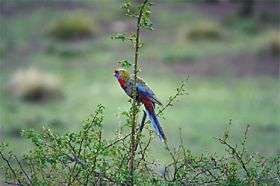Rosella research could re-write 'ring theory'

New research has uncovered how different crimson rosella populations are related to each other – a discovery which has important implications for research into how climate change may affect Australia’s biodiversity.
Published today in the prestigious journal Proceedings of the Royal Society B, the research investigates the genetic and geographical relationships between different forms of crimson rosellas and the possible ways that these forms may have arisen.
Dr Gaynor Dolman of CSIRO’s Australian National Wildlife Collection says there are three main colour ‘forms’ of the crimson rosella – crimson, yellow and orange – which originated from the same ancestral population and are now distributed throughout south eastern Australia.
“Many evolutionary biologists have argued that the different forms of crimson rosellas arose, or speciated, through ‘ring speciation’,” she says.
The ring speciation hypothesis predicts that a species that spreads to new areas may eventually join back up with itself, forming a ring. By that time, the populations at the join in the ring may be two distinct species and unable to interbreed, despite continuous gene flow, or interbreeding, between populations around the ring.
“We found that in the case of crimson rosellas, their three separate genetic groups don’t show a simple link to the geographical distribution of the colour forms,” Dr Dolman says.
“For example, orange Adelaide and crimson Kangaroo Island rosellas are separated by 15km of ocean but are genetically similar. Conversely, genetic dissimilarity was found in the geographically linked yellow and orange populations in inland south eastern Australia.
“We rejected the ring hypothesis because it predicts only one region of genetic dissimilarity, which should occur at the geographical location of the join in the ring, around the headwaters of the Murray and Murrumbidgee Rivers.
“However, it is possible that crimson rosellas formed a ring at some stage in their evolutionary history, but that the evidence has been lost through climatic or environmental changes,” she says.
Wildlife genetic research of this kind is increasing our understanding of the biogeography and evolution of Australia’s terrestrial vertebrates, helping Australia sustainably manage its biodiversity and ecosystem functions in the face of land use and climate change.
This work involved a team of researchers from CSIRO, Deakin University and the South Australian Museum.
Privided by CSIRO


















